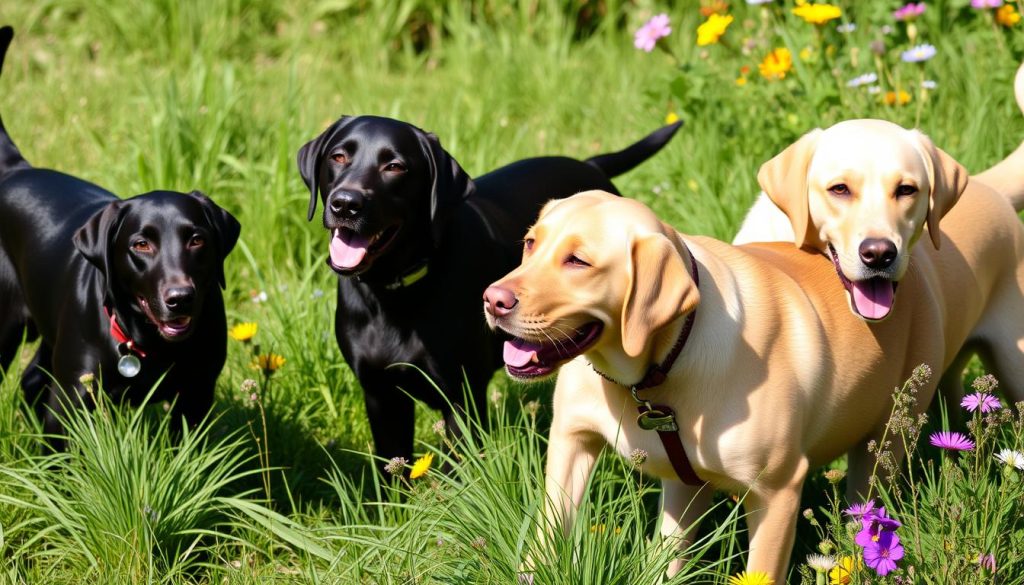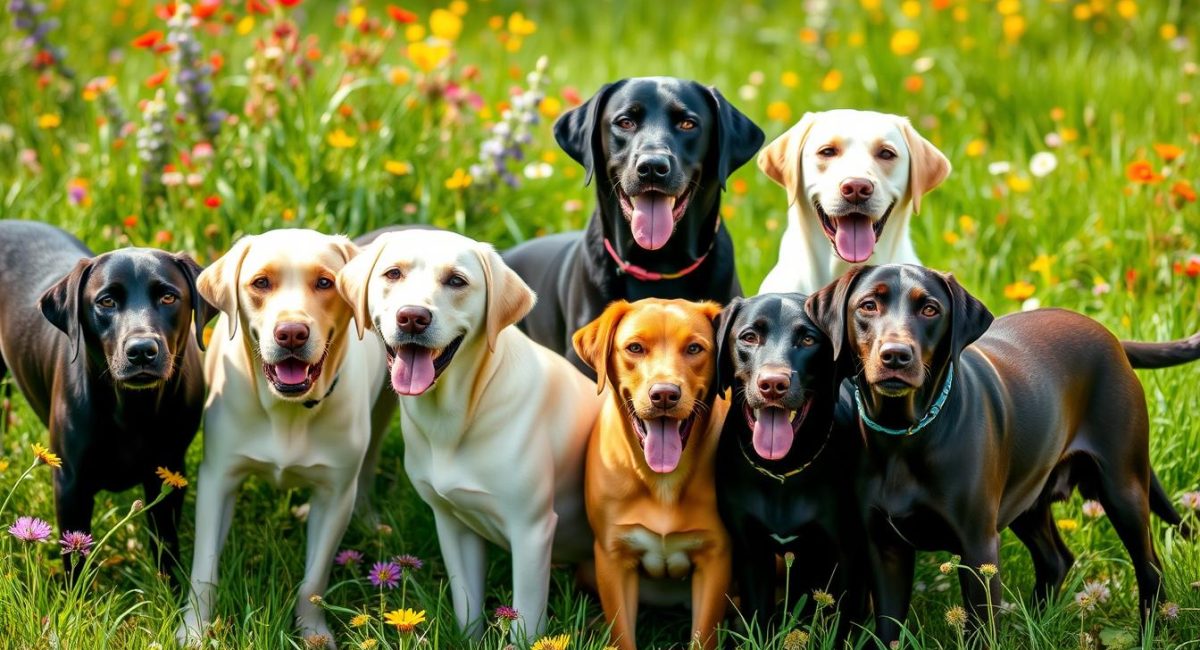Labrador Retriever Colors: What Shades Are Available?
Did you know Labradors have over a dozen colours? From classic black and chocolate to rare red fox and charcoal1. This breed is known for its smarts, loyalty, and looks. But, the many coat colours might surprise you. Let’s explore the history and genetics behind these colours.
Key Takeaways
- Labradors have three main colours: black, chocolate, and yellow, with many shades in each12.
- Black is the original colour, while chocolate and yellow came from selective breeding3.
- The Labrador’s coat colour comes from a mix of genes1.
- Rarer shades like red fox, silver, and charcoal come from a “dilute” gene mutation23.
- Knowing about Labrador colour genetics helps breeders guess coat colours in litters1.
Uncovering the Origins of Labrador Retriever Colours
The history of Labrador Retriever colours is truly captivating4. They come from St. John’s Water Dogs in Newfoundland, Canada4. Males weigh 65-80 pounds, and females 55-70 pounds4. They live for 10 to 14 years4.
The AKC says there are three main colours: Black, Chocolate, and Yellow.
Black: The Archetype Labrador Colour
Black is seen as the classic Labrador colour5. Black Labradors can be up to 24 inches tall and weigh 80lbs5. They live about 12 years, but some can live longer5.
Black is the most common colour, thanks to genetics5. But, the breed standard also accepts Chocolate and Yellow Labradors.
Chocolate and Yellow: The Hidden Hues
6 There are three main colours: yellow, black, and chocolate5. Chocolate Labradors first appeared in the 1890s4. Other colours became popular in the mid-’90s4.
Some colours, like white and silver, are not AKC-approved5. Charcoal Labs are a special case, being a dilute version of black.
Exploring the Labrador Retriever’s colour history is fascinating. It shows how the breed has evolved over time. Knowing this history gives us a deeper appreciation of their rich legacy.
Labrador Retriever Colour Genetics Explained
The colours of Labrador Retrievers come from a mix of genetics. The B locus controls a pigment called eumelanin7. More eumelanin means a black coat, while less results in chocolate or brown7.
Understanding the B Locus and Eumelanin
The B locus holds the colour genes. A ‘big B’ gene means a black coat, and ‘little b’ means chocolate7. The mix of these genes decides a Labrador’s coat colour.
The Dominant and Recessive Genes
The E locus also affects Labrador colours7. It controls pheomelanin, which adds red and yellow tones7. The mix of B and E loci creates the many colours of Labradors7.
Labradors with BB or Bb genes have black coats. Those with bb genes have brown coats7. A special K gene mutation in yellow Labradors gives them their golden colour7.
A special E gene mutation can make yellow coats by stopping eumelanin from being made7.
Labrador Retrievers come in many colours, from black to yellow7. Knowing about their genetics helps us understand their beautiful looks7.
The Dominant Black Labrador Colour
The black Labrador colour is the most common in the breed. This is because the big B gene is more powerful than the little b gene for chocolate8. A Labrador with a BB or Bb genotype will always be black, even if they have the recessive chocolate gene9. Only dogs with the bb genotype will show the chocolate colour8.
This genetic dominance has made black Labradors very popular over the years10. They have been the top choice for hunting and trials for a long time10.
The genetics of Labrador colours are simple, with the B and E loci being key9. When a chocolate Labrador (bb) is bred with a yellow Labrador (ee), half the puppies will be black (Bb) and half will be chocolate (bb)9. This makes it easier for breeders to know what colours their puppies will be.
In short, the black Labrador colour is the most common because of the B gene’s dominance8. This has helped black Labs be successful in hunting and trials, as shown by the statistics10. Knowing how Labrador colours are inherited helps breeders make better choices and predict their puppies’ colours.
What colors do Labrador Retrievers come in?
Labrador Retrievers are known for their many coat colours. The Kennel Club and the American Kennel Club (AKC) recognise three main shades: black, chocolate, and yellow11. These colours come in a wide range, from light cream to deep fox red11.
Exploring the Three Main Colours
Black Labradors are the most common. They have a solid black coat and sometimes small white markings1112. They can also show a reddish or orange tint, known as “casting,” from shedding or sun11.
Chocolate Labradors vary from light to dark chocolate. Their eye colour can be yellow to brown11. Keeping their coat uniform can be hard due to sun exposure11.
Yellow Labradors range from pale cream to deep “fox red.”11 They should have black pigment on their nose, lips, and eye rims. Without this, they might be Dudley Labradors, which are not good for breeding11.
The AKC and the Kennel Club only officially recognise these three colours. But, Labradors can have 81 different colour combinations due to their genetics112.

Some colours, like silver, charcoal, and champagne, are not true Labrador colours. They come from crossbreeding with breeds like the Weimaraner2. These colours are not recognised by the AKC and can lead to health and temperament problems2.
The Labrador Retriever’s many approved colours make them popular. They are used as service dogs, hunting companions, and in search and rescue122.
Decoding the Yellow Labrador Colour
The yellow Labrador Retriever is a favourite in the breed, known for its bright golden colour13. This colour comes from a special gene mix, called the E locus. It’s key in shaping these dogs’ looks.
The Role of the E Locus
The genes for the yellow Labrador’s coat colour come from the E genes14. These genes are different from the B genes that cause black and chocolate colours. The E gene is dominant, but the e gene can hide the darker colours, making the dog yellow.
Different E gene mixes (EE, Ee, ee) decide if a Labrador is yellow or not13. Dogs with EE or Ee are yellow. Those with ee show black or chocolate, thanks to the B genes.
Knowing about the E locus is vital for Labrador breeders13. It helps them predict and choose the right coat colours. This knowledge shows how much variety and beauty there is in the yellow Labrador’s genetics.
“The yellow Labrador’s vibrant coat is the result of a unique genetic combination, showcasing the breed’s remarkable diversity.”
Predicting Puppy Colours: A Labrador Retriever Breeder’s Guide
Predicting the exact colours of a Labrador litter is complex. The parents’ genes are key in determining the puppy coat colours1516.
The chance of different puppy coat colours can vary a lot. This includes the common black and other colours like yellow, chocolate, or liver15. The B and E genes control these colours, affecting skin and hair16.
| Genetic Makeup | Puppy Coat Colours | Probability |
|---|---|---|
| BBEE | Black | 75% |
| BBEe | Black, Black Carrying Yellow | 75% Black, 25% Yellow |
| BbEE | Black, Chocolate or Liver | 75% Black, 25% Chocolate or Liver |
| BbEe | Black, Chocolate or Liver, Yellow | 75% Black, 12.5% Chocolate or Liver, 12.5% Yellow |
Labrador breeders can predict colours by understanding the B and E genes. This knowledge helps in planning breeding to get the desired colours1516.

Genetics are crucial, but a dog’s colour may not always show its true genes15. For instance, a black Labrador might have hidden chocolate or yellow genes. This leads to surprises in the litter15. It’s vital for breeders and owners to grasp the complexity of Labrador colour inheritance151617.
Mating Two Yellow Labradors
When breeding two yellow Labradors, the outcome is simple. Research shows that all their puppies will be yellow18. This happens because yellow Labradors lack the dominant E gene needed to change the yellow colour18.
The yellow colour in Labradors comes from the genotype ee18. When two yellow Labradors with this genotype are bred, they always have yellow puppies18. This is because they pass on the recessive e gene to their puppies.
It’s key to remember that a Labrador’s eye colour, undercoat, and other traits don’t affect their genetic colour19. When breeding Labradors, health should be the main concern, not just their colour19. Unplanned litters can lead to untested parents, making health a top priority19.
In short, breeding two yellow Labradors will always result in a litter of yellow puppies18. Yet, it’s vital to focus on the health and well-being of the Labradors, not just their colour19.
The Rarer Shades: Red Fox, Silver, and Charcoal
Labradors come in more than just black, chocolate, and yellow. There are rarer shades like red fox, silver, and charcoal. These colours come from a genetic phenomenon called the dilute gene20.
Uncovering the Dilute Gene’s Impact
The dilute gene is a recessive trait that creates these unique Labrador colours21. It softens and lightens the typical Labrador colours, making them stand out21. This genetic quirk has led to the creation of red fox, silvery, and charcoal Labradors, which are highly sought after by breeders20.
The appeal of these rare colours is both practical and aesthetic20. Breeders might choose these colours for their working dogs, alongside specific talents20. Historically, colours were chosen based on a dog’s abilities, not the other way around20.
The rare colours of Labradors show the breed’s genetic diversity and the dedication of breeders20. Whether you love the fiery red fox or the sleek silver, these colours add to the breed’s charm22.
| Breed Group | Height | Weight | Life Span |
|---|---|---|---|
| Sporting group (American Kennel Club), gun dog group (United Kennel Club)22 | 21.5 to 23.5 inches (females), 22.5 to 24.5 inches (males)22 | 55 to 70 pounds (females), 65 to 80 pounds (males)22 | 10 to 12 years22 |
The dilute gene has given us these beautiful Labrador variations21. But not all colour mutations are accepted by breed authorities21. Breeders and enthusiasts must balance health and diversity, ensuring the breed’s well-being212022.
Colour Mismarks and White Markings
Labrador Retrievers are usually black, chocolate, or yellow. But sometimes, they have colour mismarks and white markings on their coats23. These rare traits make each Labrador special.
Colour mismarks can be black and tan markings, brindling, or ring-around-the-tail markings23. Tan points are another rare sight23. Brindling is a mix of colours, caused by special chromosome patterns23.
White markings on Labradors are not always mismarks24. A small white spot on the chest is common but not preferred23. But, big white patches on black Labradors are rare and interesting23.
Not all white hairs on Labradors are mismarks23. “Bolo marks” are white spots that often disappear as the dog grows up23. They’re not seen as true mismarks23.
Colour mismarks and white markings are rare in Labradors24. Breeders with many mismarked puppies might be unethical24. It’s wise to be careful when buying unregistered puppies to keep the breed pure24.
In summary, Labradors are mostly solid colours. But, they can have colour mismarks and white markings, which are okay in the breed standards. Knowing about these traits helps us see how special Labradors are.
Conclusion
The Labrador Retriever is known for its three main colours: black, chocolate, and yellow25. But, as we’ve seen, there’s a wide range of shades within these colours, from light cream to deep fox red25. Knowing how genetics affect Labrador coat colours helps us understand the full range of hues26.
The Labrador Retriever comes in many colours, including rare ones like dilute silvers25. The choice of colour depends on what you like, with black being best for hunting, chocolate for showing, and silver for looks25. The variety of colours shows the breed’s rich history and the hard work of breeders.
In short, the Labrador Retriever colours range from classic to unique, giving many options for the perfect dog27. Whether you prefer the traditional colours or the rarer ones, the Labrador Retriever is a favourite among dog lovers everywhere.
FAQ
What are the main colours of Labrador Retrievers?
Labradors have three main colours: black, chocolate, and yellow. They also have various shades. Rarer shades like red fox, silver, and charcoal are bred specifically.
How did the Labrador Retriever’s colours evolve historically?
The first Labradors were black. Chocolate and yellow ones were often killed at birth. But, these colours survived and became accepted over time.
What factors influence Labrador Retriever coat colours?
Coat colours are shaped by eumelanin pigment and genetics. The big B gene makes dogs black. The little b gene makes them chocolate. The E locus genes decide if a dog is yellow.
Why is the black Labrador colour dominant?
Black is dominant because of the big B gene. It beats the little b gene for chocolate. So, a dog with BB or Bb is black, even with chocolate genes. Only bb dogs are chocolate.
What other Labrador Retriever coat colours are recognised?
Besides black, chocolate, and yellow, Labradors have many shades. From cream to fox red, and even rarer colours like silver and charcoal.
How does the yellow Labrador colour work?
Yellow Labradors have a special E gene. This gene doesn’t affect black or chocolate. But, it can hide those colours, making the dog yellow.
How can breeders predict the colours of Labrador Retriever puppies?
Predicting puppy colours is tricky. A dog’s colour might not show its true genotype. Breeders must understand genetics to guess puppy colours.
What happens when two yellow Labradors are mated?
Two yellow Labradors always have yellow puppies. This is because they lack the E gene needed for other colours.
Are there any other Labrador Retriever coat colour variations?
Yes, Labradors can have colour mismarks or white markings. These can be on the chest, paws, or toes, adding variety to their coats.
Source Links
- Labrador Colors – The Secrets of Labrador Color Inheritance – https://www.thelabradorsite.com/labrador-colors/
- All 7 Labrador Retriever Colors And The Fun Genetics Behind Them – https://breedatlas.net/labrador-retriever-colors/
- Everything You Ever Wanted to Know About Labrador Retriever Colors – https://www.outdoorlife.com/hunting/labrador-retriever-colors/
- Labrador Retriever Dog Breed Information & Characteristics – https://dogtime.com/dog-breeds/labrador-retriever
- Black Lab – A Complete Guide to the Black Labrador Retriever – https://www.thelabradorsite.com/black-labrador/
- No title found – https://www.akc.org/expert-advice/lifestyle/fun-facts-labrador-retrievers/
- Labrador Retriever coat colour genetics – https://en.wikipedia.org/wiki/Labrador_Retriever_coat_colour_genetics
- Color Genetics of Labs – Lankas Labs – https://www.lankaslabs.com/color-genetics-of-labs/
- The Genetics of Color in Labradors – https://oakhillkennel.com/library/color.html
- Best labrador colour: does coat make a difference? – The Field – https://www.thefield.co.uk/gundogs/best-labrador-colour-31845
- ASHLAND LABRADOR RETRIEVERS – Coat Colors – https://ashlandlabradors.com/coat-colors
- Which Labrador Color is Best? – https://www.thelabradorsite.com/which-labrador-colour/
- Shades of Labrador Retrievers: Discovering their Colors – https://petproductguide.co.uk/labrador-retriever-colors/
- Fun & Friendly Facts About Labrador Retrievers – A Complete Guide – https://thisis.dog/en/dog-types/fun-friendly-facts-about-labrador-retrievers/
- High House Labradors Colours and Colour Genetics – http://www.highhouselabradors.co.uk/labradorcolours.htm
- Genetics Basics: Coat Color Genetics in Dogs | VCA Animal Hospitals – https://vcahospitals.com/know-your-pet/genetics-basics-coat-color-genetics-in-dogs
- Science Corner: Coat Color Genetics 101 – https://embarkvet.com/resources/science-corner-coat-color-genetics-101-2/
- Labrador Colors – Rocky River Retrievers – https://www.rockyriverretrievers.com/labrador-colors/
- Chocolate / yellow breeding? – https://www.labradorforums.co.uk/threads/chocolate-yellow-breeding.83110/
- Silver and fox red labs – https://www.retrievertraining.net/threads/silver-and-fox-red-labs.222143/
- MoonLit Labradors – Color Myth | MoonLit Labradors | Black, Yellow, and Chocolate – https://moonlitlabradors.com/color-myth/
- Fox red Labrador retriever: Dog breed characteristics, pictures, care tips – https://betterpet.com/fox-red-labrador-retriever/
- Mismarks | Greenstone Labradors – https://www.greenstonelabradors.com/mismarks
- Those Unusual Mismarks – http://blueknightlabs.com/mismarks/index.html
- QUICK GUIDE: THE BEST LABRADOR COLOR FOR YOU – https://medium.com/@lovelabworld1/quick-guide-the-best-labrador-color-for-you-198823d3aa8e
- Does a lab’s coat color matter – SnowyPines – https://www.snowypineswhitelabs.com/guides/does-a-labs-coat-color-matter/
- Labrador Retriever – https://en.wikipedia.org/wiki/Labrador_Retriever

